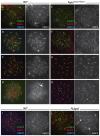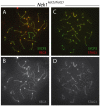NEK1 Facilitates Cohesin Removal during Mammalian Spermatogenesis
- PMID: 21931878
- PMCID: PMC3175124
- DOI: 10.3390/genes2010260
NEK1 Facilitates Cohesin Removal during Mammalian Spermatogenesis
Abstract
Meiosis is a highly conserved process, which is stringently regulated in all organisms, from fungi through to humans. Two major events define meiosis in eukaryotes. The first is the pairing, or synapsis, of homologous chromosomes and the second is the exchange of genetic information in a process called meiotic recombination. Synapsis is mediated by the meiosis-specific synaptonemal complex structure in combination with the cohesins that tether sister chromatids together along chromosome arms through prophase I. Previously, we identified FKBP6 as a novel component of the mammalian synaptonemal complex. Further studies demonstrated an interaction between FKBP6 and the NIMA-related kinase-1, NEK1. To further investigate the role of NEK1 in mammalian meiosis, we have examined gametogenesis in the spontaneous mutant, Nek1kat2J. Homozygous mutant animals show decreased testis size, defects in testis morphology, and in cohesin removal at late prophase I of meiosis, causing complete male infertility. Cohesin protein SMC3 remains localized to the meiotic chromosome cores at diplonema in the Nek1 mutant, and also in the related Fkbp6 mutant, while in wild type cells SMC3 is removed from the cores at the end of prophase I and becomes more diffuse throughout the DAPI stained region of the nucleus. These data implicate NEK1 as a possible kinase involved in cohesin redistribution in murine spermatocytes.
Figures









Similar articles
-
Cohesin Removal along the Chromosome Arms during the First Meiotic Division Depends on a NEK1-PP1γ-WAPL Axis in the Mouse.Cell Rep. 2016 Oct 18;17(4):977-986. doi: 10.1016/j.celrep.2016.09.059. Cell Rep. 2016. PMID: 27760328 Free PMC article.
-
Essential role of Fkbp6 in male fertility and homologous chromosome pairing in meiosis.Science. 2003 May 23;300(5623):1291-5. doi: 10.1126/science.1083022. Science. 2003. PMID: 12764197 Free PMC article.
-
Meiosis-specific cohesin component, Stag3 is essential for maintaining centromere chromatid cohesion, and required for DNA repair and synapsis between homologous chromosomes.PLoS Genet. 2014 Jul 3;10(7):e1004413. doi: 10.1371/journal.pgen.1004413. eCollection 2014 Jul. PLoS Genet. 2014. PMID: 24992337 Free PMC article.
-
Meiotic prophase-like pathway for cleavage-independent removal of cohesin for chromosome morphogenesis.Curr Genet. 2019 Aug;65(4):817-827. doi: 10.1007/s00294-019-00959-x. Epub 2019 Mar 28. Curr Genet. 2019. PMID: 30923890 Review.
-
Rec8 Cohesin: A Structural Platform for Shaping the Meiotic Chromosomes.Genes (Basel). 2022 Jan 22;13(2):200. doi: 10.3390/genes13020200. Genes (Basel). 2022. PMID: 35205245 Free PMC article. Review.
Cited by
-
Cohesin Removal along the Chromosome Arms during the First Meiotic Division Depends on a NEK1-PP1γ-WAPL Axis in the Mouse.Cell Rep. 2016 Oct 18;17(4):977-986. doi: 10.1016/j.celrep.2016.09.059. Cell Rep. 2016. PMID: 27760328 Free PMC article.
-
Checking NEKs: Overcoming a Bottleneck in Human Diseases.Molecules. 2020 Apr 13;25(8):1778. doi: 10.3390/molecules25081778. Molecules. 2020. PMID: 32294979 Free PMC article. Review.
-
NEK Family Review and Correlations with Patient Survival Outcomes in Various Cancer Types.Cancers (Basel). 2023 Mar 30;15(7):2067. doi: 10.3390/cancers15072067. Cancers (Basel). 2023. PMID: 37046733 Free PMC article. Review.
-
NIMA-related kinase 1 (NEK1) regulates meiosis I spindle assembly by altering the balance between α-Adducin and Myosin X.PLoS One. 2017 Oct 5;12(10):e0185780. doi: 10.1371/journal.pone.0185780. eCollection 2017. PLoS One. 2017. PMID: 28982183 Free PMC article.
-
On Broken Ne(c)ks and Broken DNA: The Role of Human NEKs in the DNA Damage Response.Cells. 2021 Feb 27;10(3):507. doi: 10.3390/cells10030507. Cells. 2021. PMID: 33673578 Free PMC article. Review.
References
-
- Handel M.A., Schimenti J.C. Genetics of mammalian meiosis: Regulation, dynamics and impact on fertility. Nat. Rev. Genet. 2010;11:124–136. - PubMed
-
- Hassold T., Hunt P. To err (meiotically) is human: The genesis of human aneuploidy. Nat. Rev. Genet. 2001;2:280–291. - PubMed
-
- Hassold T., Hunt P.A., Sherman S. Trisomy in humans: Incidence, origin and etiology. Curr. Opin. Genet. Dev. 1993;3:398–403. - PubMed
-
- Hassold T., Abruzzo M., Adkins K., Griffin D., Merrill M., Millie E., Saker D., Shen J., Zaragoza M. Human aneuploidy: Incidence, origin, and etiology. Environ. Mol. Mutagen. 1996;28:167–175. - PubMed
Grants and funding
LinkOut - more resources
Full Text Sources
Miscellaneous
